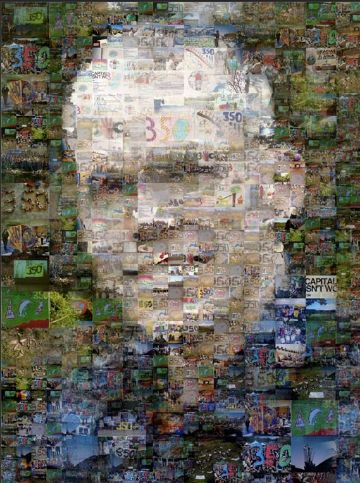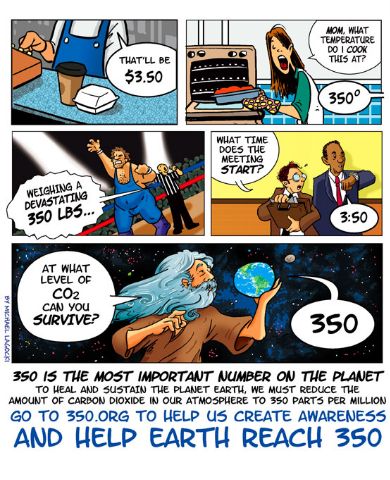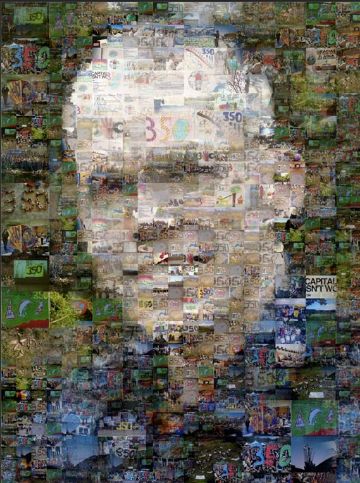That pleading little essay I wrote in 2005? It was probably the last moment I could have written it. Clearly there were lots and lots of people already thinking the same way, because ever since it’s seemed to me as if deep and moving images and sounds and words have been flooding out into the world.
 Bill, built from Flickr pix.Kalman Gacs, 350.org/galleryThat torrent of art has been, often, deeply disturbing — it should be deeply disturbing, given what we’re doing to the earth. (And none of it has quite matched the performance work that nature itself is providing. Check out, for instance, James Balog’s time-lapse photography of glaciers crashing into the sea — if we could somehow crowd that thrashing sheet of ice into the Guggenheim for a week, people would truly get it.) But for me, it’s been more comforting than disturbing, because it means that the immune system of the planet is finally kicking in.
Bill, built from Flickr pix.Kalman Gacs, 350.org/galleryThat torrent of art has been, often, deeply disturbing — it should be deeply disturbing, given what we’re doing to the earth. (And none of it has quite matched the performance work that nature itself is providing. Check out, for instance, James Balog’s time-lapse photography of glaciers crashing into the sea — if we could somehow crowd that thrashing sheet of ice into the Guggenheim for a week, people would truly get it.) But for me, it’s been more comforting than disturbing, because it means that the immune system of the planet is finally kicking in.
Artists, in a sense, are the antibodies of the cultural bloodstream. They sense trouble early, and rally to isolate and expose and defeat it, to bring to bear the human power for love and beauty and meaning against the worst results of carelessness and greed and stupidity. So when art both of great worth, and in great quantities, begins to cluster around an issue, it means that civilization has identified it finally as a threat. Artists and scientists perform this function most reliably; politicians are a lagging indicator.
But once a threat has been identified, the attack has to be at least a little organized. Which is why I’m so pleased that many artists are not just doing their own thing, but also increasingly figuring out how to come together to make the sum of their voices louder than the individual parts. Let me use the example that’s closest at hand: the 350.org campaign that I’ve been helping run this past year, the biggest global grassroots effort on climate change.
We’re working with ministers and mountain climbers and youth networks and even politicians. But with artists too. I’ve been shamelessly asking friends to shape their work to fit our message: that 350, as in parts per million CO2, is the most important number in the world, that beyond it the world simply doesn’t work in the ways it must for our civilization to survive. And people have responded in remarkable ways. You can see many of them on our website, from crafters to fine artists to someone who somehow managed to make a portrait of me from hundreds of Flickr photos of 350 demonstrations around the world. (I’ve always hated looking at pictures of myself, but that one I stared at for a long time, because it seemed to illustrate a principle that matters to me: we are who we are because of our connection to others.) 350.org is one of the first campaigns I know of with an official artist-in-residence, Kevin Buckland, who is coordinating as best he can many of these contributions. But mostly it’s like a potluck supper. Everyone is bringing what they do best.
We’ve asked writers if they would pen 350-word poems and essays, and many have responded. Here’s the great Chilean writer Ariel Dorfman, for instance.
Photographers are organizing around the world, not only to send us images, but also to document the thousands of actions that will be taking place on October 24 on our global day of action. (That day itself will be a carnival of performance art; I’ve just come from helping cobble together what we think will be the world’s largest underwater demonstration, in the Maldive Islands.) We’ll take the pictures they upload from around the planet and show them on a giant screen at the U.N. that day, and then deliver prints to every delegate and negotiator.
Amazing artists keep stepping up to fill needs we didn’t even know existed. John Quigley, for instance, who is the Rembrandt of what you might call aerial art — arranging human beings on the ground to make a point from above. Here’s a picture from Poznan in Poland, and from Bonn, Germany, and from Bali, Indonesia. (See more aerial art in our performance art slideshow.)
Musicians too. Some of them world-famous: Moby will apparently headline a concert/rally on the big day in Mexico City, and Groove Armada in the U.K.; Sigur Rós let us use a song of theirs on our most recent organizing video. Fred Small provided us a marching song that we put to great use when we helped shut down the Capitol Hill Power plant in Washington in March. Rev. Lennox Yearwood and the Hip Hop Caucus have been helping us plan events across the country that use a different beat than old-school environmentalists are used to. Today’s email brought not one but two cuts from one of my favorite pairs of singers, Michigan’s Seth Bernard and May Erlewine. I asked them — humbly but insistently — for a song; they went to work. That’s how it’s been with pretty much everyone. (Read more about climate-change tunes and North American bands going green.)
 A graphic depiction of the task at hand.Michael Lagocki, 350.org/galleryThere’s no limit to the stuff we can use, from pros and from amateurs. Crafters have sent in endless great patterns; graffiti artists have started taking the number to the streets and building buzz; dancers have been creating dances of 350 steps and more; great video artists put together our first organizing video, which has now been seen all over the planet.
A graphic depiction of the task at hand.Michael Lagocki, 350.org/galleryThere’s no limit to the stuff we can use, from pros and from amateurs. Crafters have sent in endless great patterns; graffiti artists have started taking the number to the streets and building buzz; dancers have been creating dances of 350 steps and more; great video artists put together our first organizing video, which has now been seen all over the planet.
My point four years ago was that we needed art to help build a general consciousness about climate change, the greatest problem we’ve ever faced. That’s happened. Now we need to focus some of that beauty and witness and anger sharply enough to help spur deep and lasting change. It’s always hard for any of us who are writers and musicians and visual artists to subordinate our own personal vision even a little — that’s what makes us artists. But the pleasure of working together in common cause more than makes up for the imposition. Please join us!



